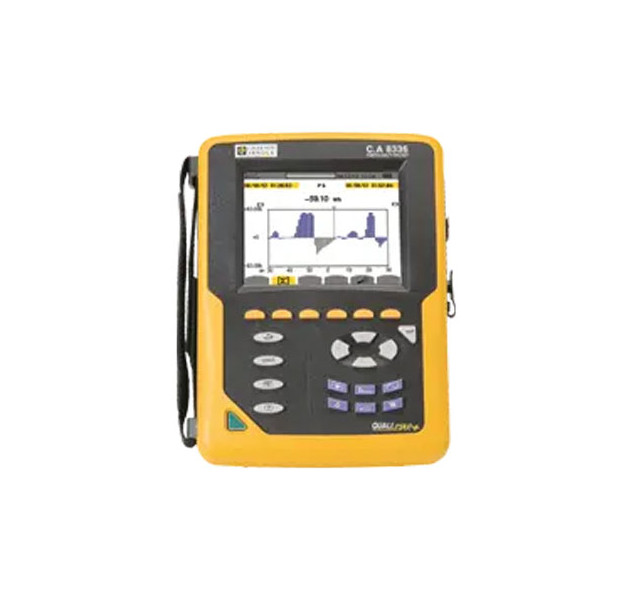QUALISTAR+ C.A.8336
The C.A. 8336 (Qualistar+) is a three-phase network analyzer with colour graphic display and built-in rechargeable battery.
It plays three roles, and can be used:
- To measure the RMS values, powers, and perturbations of electric distribution networks.
- To deliver a snapshot of the principal characteristics of a three-phase network
- To track the variations of various parameters over time.
The measurement uncertainty of the device is better than 1% (not counting the uncertainties due to the current sensors). The device is also very flexible, with a choice of sensors allowing measurements ranging from a few milliamperes (MN93A) to several kiloamperes (AmpFlex®).
The device is compact and impact resistant.
The ergonomics and simplicity of its interface make using it pleasant.
The C.A 8336 is intended for the technicians and engineers of electrical installation and network inspection and maintenance teams.
- TRMS AC+DC voltage up to 1,000 V
- TRMS AC+DC current: 5 mA to 10 kA depending on the sensors
- Frequency
- Power values: W, VA, var, VAD, PF, DPF, cos φ, tan φ
- Energy values: Wh, varh, VAh, VADh, BTU, toe, Joule,
- Harmonics from 0 to the 50th order, phase
- Transients: up to 210
- Inrush with waveform over a period > 10 minutes
- TrueInrush function
- Recording of a selection of parameters at the maximum sampling rate for several days to several weeks
- Alarms: 10,000 of 40 different types
- Peak detection
- Vectorial representation
- Available in more than 27 languages
- IP53 / IK08
- USB communication
- IEC 61000-4-30 Class B
- Dimensions / weight: 240 x 180 x 55 mm / 1.9 kg
The principal measurements made are:
The RMS values of AC voltages up to 1000 V between terminals. By using the ratios, the device can measure voltages up to hundreds of gigavolts.
The RMS values of AC currents up to 10,000 amperes (neutral included). By using the ratios, the device can measure currents up to hundreds of kiloamperes.
The DC components of voltages and currents (neutral included).
Minimum and maximum half-cycle RMS voltage and current values (excluding neutral).
Peak voltage and current values (neutral included).
The frequency of 50 Hz and 60 Hz networks.
Current and voltage peak factors (neutral included).
Calculation of the harmonic loss factor (FHL), application to transformers in the presence of harmonic currents.
Calculation of the K factor (KF), application to transformers in the presence of harmonic currents.
Measurement of total harmonic distortion with respect to the fundamental (THD in % f) of the current and of the voltages
(excluding neutral).
Measurement of the total harmonic distortion with respect to the RMS AC value (THD in % r) for the current and the voltages
(neutral included)
Active, reactive (capacitive and inductive), non-active, distortion, and apparent power, by phase and cumulative (excluding neutral).
Power factor (PF) and displacement factor (DPF or cos (excluding neutral).
Measurement of the RMS distortion value (d) for the current and the voltages (excluding neutral).
Short-term voltage flicker (PST) (excluding neutral).
Measurement of the long-term flicker of the voltages (PLT) (excluding neutral).
Active, reactive (capacitive and inductive), non-active, distortion, and apparent energy (excluding neutral).
Current and voltage harmonics (excluding neutral) up to order 50: RMS value, percentage referred to the fundamental, (%f) (excluding neutral), or the total RMS value (%r), minimum and maximum and sequence harmonics.
Apparent harmonic powe up to order 50 (excluding neutral): percentages referred to the fundamental apparent power (%f) or the total apparent power (%r), minimum and maximum of a rank.
Inrush currents, starting of motors.
Display of waveforms (voltages and currents).
Display of frequency bar chart (voltages and currents).
Inrush Current function: displays parameters useful for study of the starting of a motor.
Instantaneous current and voltage at the instant designated by the cursor.
Maximum instantaneous absolute value of the current and of the voltage (over the entire starting time).
RMS value of the half-cycle (or lobe) of the current and voltage (excluding neutral) on which the cursor is positioned.
Maximum half-cycle RMS current (over the entire starting time).
Instantaneous network frequency at the instant designated by the cursor.
Maximum, mean, and minimum network frequencies (over the entire starting time).
Time at which starting of motor commenced.
Screen captures (50 maximum).
Transients function. Detection and recording of transients (up to 210) between user-defined start and stop dates and times.
Recording of 4 complete cycles (one before the triggering event and three after) in the 8 acquisition channels.
Trend recording (data logging) function. 2GB memory with date-stamping and user-defined start and stop dates for recording, with a maximum of 100 recordings. Display, in bar chart or curve form, of the means of many parameters vs. time, with or without minima and maxima.
Alarm function. List of recorded alarms (up to 16,362) exceeding thresholds defined in the configuration menu. User-defined
alarm monitoring start and stop times.
Date and time setting.
Screen brightness setting.
Choice of curve colours.
Choice of management of switching off of the screen.
Choice of display in night mode.
Choice of calculation methods (non-active quantities broken down or not, choice of the unit of energy, choice of the coefficients
of calculation of the K factor, choice of reference for the level of harmonics, PLT calculation (sliding or not).
Choice of distribution system (single-phase, two-phase, three-phase with or without neutral) and of the connection method
(standard, 2-element method or 2½-element method).
Configuration of recording, alarms, inrush currents, and transients.
Erasure of data (total or partial).
Display of software and hardware version numbers.
Choice of language.
Display of current sensors detected not detected, not managed, simulated or impossible to simulate (2-element connection method) . Setting of voltage and current ratio, of the transduction ratios and of the sensitivity.






